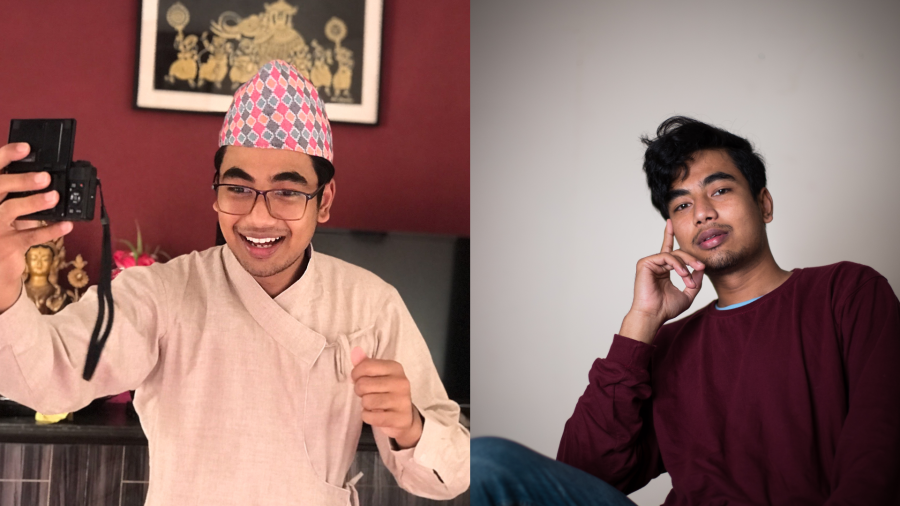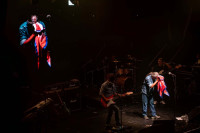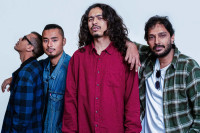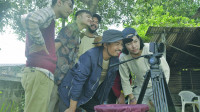Entertainment
How this young artist is creating space for comedy online
Aashutosh Barahi, 24, started creating and uploading comedy sketches in Nepalbhasa on YouTube during lockdown for fun and they became instant hits. Now, he’s thinking of making a career out of it.
Ankit Khadgi
Dressed in a daura suruwal, with Dhaka topi on his head, Ba orders his son (both played by Aashutosh Barahi) to bring Nhey gah (seven) eggs from a nearby shop. The son gets confused because his father gives him the instructions in Nepalbhasa, which he, like many of the younger generation, struggles to understand or speak with ease.
This is the premise of the video that Barahi published on YouTube, on his YouTube channel, AashutoshBrh, back in May that shot him to instant popularity. By making a comedy sketch on this confusion over language between two people of different generations, which many young people can relate to, he tapped into an alternative space on YouTube for the Newa community to watch and enjoy sketches and comedy in Nepalbhasa.
But according to Barahi, this was something that he never had planned to do and his sudden popularity is all unexpected. “During the lockdown, I was feeling unproductive and started uploading small clips of comedy sketches on YouTube just to utilise my time,” says Barahi.
“I hadn’t expected that the sketch would become so popular. I was reluctant to upload it. I was also worried that the number of people who would understand it were limited, as only Newa people could relate with it,” says Barahi. “But I thought I would give it a try and see how people would react to it.”
The video in Nepal Bhasa, about the struggles faced by young Newa people for not being able to count in the indigenous language, became viral quickly. While his previous uploads usually received 200-300 views on average, the Nepalbhasa video received 2,000 views in a day, with people starting to share the video on their social media accounts as well. Today, almost all his videos in Nepalbhasa have 60-70 thousand views. “I was happy to see the response my videos were getting. Seeing the comments and the reception from both younger and older generations, I realised that there can be space to do comedy in my own mother tongue—Nepalbhasa—on the internet,” says Barahi.
While the sudden popularity was overwhelming, Barahi was well-versed with the inner workings of YouTube. He has been filming and editing videos since 2016, on his own channel, where he used to upload vlogs and comedy skits, which he stopped doing briefly when he had to focus on his studies.
However, after graduating as an IT student in 2017, he started regularly uploading short sketches on Instagram to constantly practise and learn the art of making people laugh.
Encouraged with the good response and engagement he received in his first video, he uploaded his next video on his channel within a week. “I understood that people could relate to my first video as it was about something that happened to them. That’s why I decided to work on scripts and themes taking inspiration from everyday life,” says Barahi, who writes, edits, acts and shoots all of his videos by himself.
Since May, he has uploaded 11 videos on his YouTube channel, which all come with Nepali subtitles as well. But his sketches aren’t just based on funny incidents. He has incorporated comedy along with talking about various cultural and religious festivals as well as diversity within the Newa community.
From making a video on Sithi Nakha, an important festival of Newa community, to making a vlog about how the chariot of Bunga Dyah (Rato Machindranath) is built, Barahi’s videos give space to a comedy that educates as well as entertains—especially young people. “Many of the young generations of Newa people do not have enough knowledge about their culture and language. Through my sketches I am intending to use comedy in a way that can make people laugh as well as preserve and promote Newa culture,” he says.
But things aren’t as easy as it sounds, he says. The comedy scene in Nepal is still nascent, with few young comedians, and even these few comedians are viewed stereotypically, which is not encouraging, says Barahi. Another issue he has to be careful about is to make people genuinely laugh without hurting the sentiments of any community.
For that, he does a lot of research and watches a lot classic Newa movies. “I have been spending a lot of my time watching old Newa movies to understand what content can make more people laugh as well relate to my content,” says Barahai. For instance, after watching ‘Hisimadu’, he realised that giving a catchy line to Ba’s character would be a great hook for viewers.
And that’s how the line, ‘Aa dhasa dhala dhaika’, which means ‘Aba vanya bhane bhanyo bhancha’ in Nepali, came to be. The line is regularly used by the character of Ba, says Barahi. “Many people loved the catchphrase and said that it was their favourite. And this is why I decided to use it regularly, as it was engaging the viewers,” says Barahi.
Likewise, he says he has been constantly following Saturday Night Live shows, reading books on comedy as well as watching comedy sketches by other comedians to analyse what can make people laugh.
However, right now his sole focus is doing observational comedy in Nepalbhasa. “Making comedy sketches in Nepalbhasa on YouTube has made me unique from the rest,” says Barahi. “And I would like to see where this goes.”
In just a couple of months, he’s been getting offers from brands for collaboration, he says. With such a positive response and because of his burgeoning popularity, he believes that platforms like YouTube are a great platform for self-expression as well as a great space for indigenous, independent creative content to thrive.
“I receive phone calls from my family members if I don’t upload videos on time,” says Barahi. “What started out as just an attempt to pass my time made me realise the value of representation and how people can easily enjoy and relate to content that depicts their culture,” he says.




 16.12°C Kathmandu
16.12°C Kathmandu










